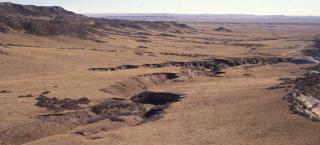
Story
Archaeology Month
Lindenmeier Site
The National Park Service National Register of Historic Places program celebrates August as Archaeology month. Given the weather, it’s a great time to get outside and take advantage of the last of summer before school. There are many publicly accessible sites that speak to Colorado’s rich archaeological heritage and all these sites can reveal to us about the past.
Lindenmeier Site, Fort Collins vicinity, Larimer County, listed in the National Register in 1966, National Historic Landmark designated in 1961
The site, located in the Soapstone Prairie Natural Area, was one of the first nationally to afford archaeologists an opportunity to study the Folsom culture of the Paleo-Indian era. Discovered in 1924 and excavated initially in the 1930s by the Colorado Museum of Natural History (now Denver Museum of Nature and Science) and Smithsonian Institution, the site conclusively dated human habitation in North America to more than 10,000 years ago. Activity at the extensive site dates from 9000 to 3000 BP and reveals a culture strongly dependent on hunting. American Indian perspectives, or ways of knowing, have strongly contributed to our current understanding of how the site functioned.
Lindenmeier is one of only 25 designated National Historic Landmarks (NHL) in Colorado. NHLs are nationally significant historic places designated by the Secretary of the Interior because they possess exceptional value or quality in illustrating or interpreting the heritage of the United States.
It is important to remember when visiting an archaeological site such as Lindenmeier to remain on prescribed trails. In the unlikely event of seeing an artifact, leave it in place. This is a sign not only of respect, both of historic peoples and of the research value of archaeological sites which rely on context, but it is illegal to remove, excavate, damage, or destroy prehistoric or historic archaeological resources.
Additional information about excavations, both historically and recently, at Lindenmeier can be found here:
https://www.fcgov.com/naturalareas/pdf/legacy2014.pdf?1399309549
http://fcmod.org/wp-content/uploads/2013/lindenmeier.pdf
http://beta.historycolorado.org/story/preservation/2014/09/25/interpreting-prehistoric-lindenmeier
Lindenmeier Overlook trail is ¼ miles and paved to a pavilion with seating. Free and customized guided hikes are available with advance notice. For more information and directions to visit the site: https://www.fcgov.com/naturalareas/finder/soapstone. Soapstone Prairie is closed December-February.
The National Register of Historic Places and Colorado State Register of Historic Properties are tools that recognize National Archaeology Month, celebrated in August. The National Register of Historic Places is the official list of the Nation's historic places worthy of preservation. Authorized by the National Historic Preservation Act of 1966, the National Park Service's National Register of Historic Places is part of a national program to coordinate and support public and private efforts to identify, evaluate, and protect America's historic and archeological resources. The Colorado State Register of Historic Properties is a listing of the state’s significant cultural resources worthy of preservation for the future education and enjoyment of Colorado’s residents and visitors. Properties listed in the National Register of Historic Places are automatically placed in the Colorado State Register. They may also be nominated separately to the Colorado State Register without inclusion in the National Register.
The Office of Archaeology and Historic Preservation’s Heritage Diversity Initiative seeks to celebrate the historic places significant to people of every language, culture, and background that comprise the Colorado story. Check out the growing list of historic places at: www.historypin.org/en/person/75043. Submit your own story as well, either there or at: www.historycolorado.org/oahp/heritage-diversity-initiative.
